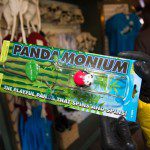It’s Panda-monium as Panda Cub Bao Bao Makes Her Public Debut at National Zoo (Photos)
By • February 20, 2014 0 1845

Thousands of animal lovers braved the cold weather and construction on the Metro Red Line to greet four-month-old giant panda cub Bao Bao for her first day on public display at the Smithsonian National Zoological Park on Jan. 18. The giant-panda house, which had been closed to the general public for six months, re-opened for extended hours for the three-day Martin Luther King, Jr., weekend to accommodate the expected 10,000 visitors. They would be allowed only 10 to 15 minutes at a time in front of the baby panda, but many would come back to wait in line for a second or a third look. Although members of the Friends of the National Zoo had already been given preview peeks, this Saturday marked the first time members of the general public would be allowed to view the 18-1/2 pound cub . (When fully grown, female giant pandas weigh in excess of 200 pounds.) Infant pandas sleep quite a bit, up to 20 hours a day, and visitors were warned not to expect too much action from Bao Bao. We were lucky to see the cub wide awake for some exercise with handler Nicole MacCorkle. Bao Bao’s mother, Mei Xiang, was enjoying a meal of bamboo in the adjoining enclosure. The amount of time that visitors will be able to see Bao Bao will vary, depending on how much time the panda spends in her private den. Zookeepers try to allow animals as much free will as possible. Our advice: make this your first stop on your visit to the zoo. If the panda is out of view or asleep, just come back a bit later in the day.
Bao Bao was born August 23, 2013. She was the first giant panda to survive birth at the zoo since 2005. Many watched the event on the Pandacam. Bao Bao, which means “precious” or “treasure,” was formally named 100 days later. More than 123,000 votes were cast on the cub’s new name on Smithsonian.com.
Giant pandas live in a few mountain ranges in central China, in Sichuan, Shaanxi and Gansu provinces. They have been classified as endangered in the World Conservation Union’s Red List of Threatened Species. There are an estimated 1,600 living in the wild and another 300 in zoos and breeding centers around the world, mostly in China. Their diet is almost exclusively bamboo.
View our photos from Bao Bao’s opening day by clicking on the photo icons below.
- Bao Bao | Jeff Malet























